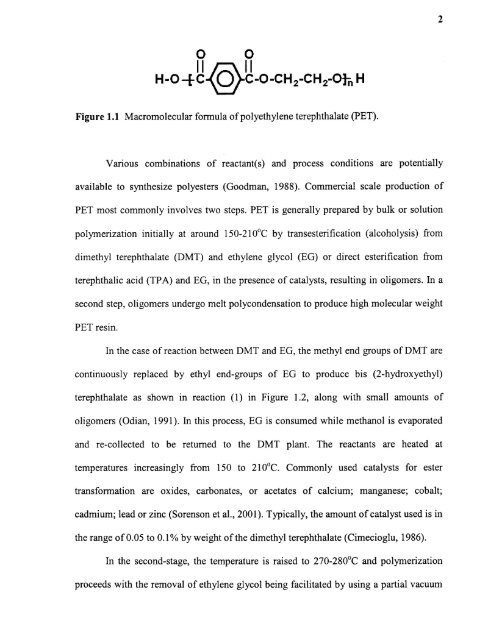A reactive melt modification of polyethylene terephthalate
A reactive melt modification of polyethylene terephthalate
A reactive melt modification of polyethylene terephthalate
Create successful ePaper yourself
Turn your PDF publications into a flip-book with our unique Google optimized e-Paper software.
2<br />
Figure 1.1 Macromolecular formula <strong>of</strong> <strong>polyethylene</strong> <strong>terephthalate</strong> (PET).<br />
Various combinations <strong>of</strong> reactant(s) and process conditions are potentially<br />
available to synthesize polyesters (Goodman, 1988). Commercial scale production <strong>of</strong><br />
PET most commonly involves two steps. PET is generally prepared by bulk or solution<br />
polymerization initially at around 150-210°C by transesterification (alcoholysis) from<br />
dimethyl <strong>terephthalate</strong> (DMT) and ethylene glycol (EG) or direct esterification from<br />
terephthalic acid (TPA) and EG, in the presence <strong>of</strong> catalysts, resulting in oligomers. In a<br />
second step, oligomers undergo <strong>melt</strong> polycondensation to produce high molecular weight<br />
PET resin.<br />
In the case <strong>of</strong> reaction between DMT and EG, the methyl end groups <strong>of</strong> DMT are<br />
continuously replaced by ethyl end-groups <strong>of</strong> EG to produce bis (2-hydroxyethyl)<br />
<strong>terephthalate</strong> as shown in reaction (1) in Figure 1.2, along with small amounts <strong>of</strong><br />
oligomers (Odian, 1991). In this process, EG is consumed while methanol is evaporated<br />
and re-collected to be returned to the DMT plant. The reactants are heated at<br />
temperatures increasingly from 150 to 210 °C. Commonly used catalysts for ester<br />
transformation are oxides, carbonates, or acetates <strong>of</strong> calcium; manganese; cobalt;<br />
cadmium; lead or zinc (Sorenson et al., 2001). Typically, the amount <strong>of</strong> catalyst used is in<br />
the range <strong>of</strong> 0.05 to 0.1% by weight <strong>of</strong> the dimethyl <strong>terephthalate</strong> (Cimecioglu, 1986).<br />
In the second-stage, the temperature is raised to 270-280 °C and polymerization<br />
proceeds with the removal <strong>of</strong> ethylene glycol being facilitated by using a partial vacuum

















